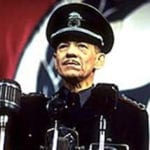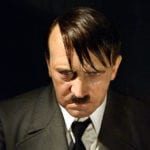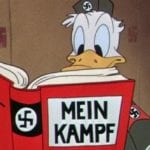 Music
Music  Music
Music  History
History 10 Less Than Jolly Events That Occurred on December 25
 Weird Stuff
Weird Stuff 10 Funny Ways That Researchers Overthink Christmas
 Politics
Politics 10 Political Scandals That Sent Crowds Into the Streets
 Weird Stuff
Weird Stuff Ten Bizarre Facts About The Doge Meme
 Our World
Our World 10 Ways Your Christmas Tree Is More Lit Than You Think
 Movies and TV
Movies and TV The 10 Coolest Stars to Set Sail on The Love Boat
 History
History 10 Things You Didn’t Know About the American National Anthem
 Technology
Technology Top 10 Everyday Tech Buzzwords That Hide a Darker Past
 Humans
Humans 10 Everyday Human Behaviors That Are Actually Survival Instincts
 Music
Music 10 Surprising Origin Stories of Your Favorite Holiday Songs
 History
History 10 Less Than Jolly Events That Occurred on December 25
 Weird Stuff
Weird Stuff 10 Funny Ways That Researchers Overthink Christmas
Who's Behind Listverse?

Jamie Frater
Head Editor
Jamie founded Listverse due to an insatiable desire to share fascinating, obscure, and bizarre facts. He has been a guest speaker on numerous national radio and television stations and is a five time published author.
More About Us Politics
Politics 10 Political Scandals That Sent Crowds Into the Streets
 Weird Stuff
Weird Stuff Ten Bizarre Facts About The Doge Meme
 Our World
Our World 10 Ways Your Christmas Tree Is More Lit Than You Think
 Movies and TV
Movies and TV The 10 Coolest Stars to Set Sail on The Love Boat
 History
History 10 Things You Didn’t Know About the American National Anthem
 Technology
Technology Top 10 Everyday Tech Buzzwords That Hide a Darker Past
 Humans
Humans 10 Everyday Human Behaviors That Are Actually Survival Instincts
10 Disney Propaganda Cartoons From World War II
Walt Disney cartoons are known for having family-friendly values. It is not surprising to see social commentary slipping through, even in the cartoons we see made by Disney and Pixar in theaters today.
During World War II, Walt Disney was commissioned by the US and Canadian governments to create war propaganda for war bonds and taxes. Walt Disney and the government agreed that they were both anti-Hitler. However, in his own time, Disney created antiwar cartoons, as well as humanitarian messages to American audiences to spread the message that they needed to sympathize with their enemies, who were, after all, fellow human beings.
10Der Fuehrer’s Face
Der Fuehrer’s Face won the Academy Award for Best Animated Short Subject in 1943. The plot surrounds Donald Duck, who wakes up in a world controlled by the Nazis. He starts his day woken up at the crack of dawn, and he puts on a Nazi uniform. He quietly dips a cube of his compressed coffee rations into a cup of hot water, sprays “Eau de Bacon and Eggs” into his mouth, and eats one piece of stale bread. His breakfast is complete.
Donald Duck continues his day working in a factory, where he is under constant surveillance to make sure he is saying “Heil Hitler” enough, and that he never speaks out with his typically disgruntled personality. Guns are pointed at his head the moment he gets out of line, and he trembles, saying “Heil Hitler.” Donald starts to go crazy under the pressure, but by the end, he wakes up in The United States, and he realizes that it was all a dream. He is suddenly overjoyed at his privilege to be a citizen of the USA.
9All Together
This short cartoon was made for the Canadian War Bond effort in 1941. In the midst of World War II, the USA and Canada asked ordinary citizens for help to pay for the war. Someone could buy a war bond worth $25 for only $18.75. It was a win-win situation, because it meant that people could invest, make a profit, and help their country at the same time.
The title card of “All Together” shows the British and Canadian flags blending, followed by a variety of Disney characters marching in a parade together. Despite coming from different movies, as the title suggests, the characters from Snow White, Pinocchio, and classic characters like Mickey, Goofy, and the gang are “All Together” in a marching band, holding banners encouraging viewers to help win the war. Advertising five war bonds for the price of four, this commercial encourages Canadians to invest because it could help them win the war. “You serve by saving. Keep your money fighting, until the war is won.”
8Donald Gets Drafted
This short cartoon begins with Donald walking past US Army propaganda signs encouraging men to join the army—along with a song called “The Army’s Not the Army Anymore,” depicting life as a soldier as one of being courted by beautiful women, breakfast in bed, and guaranteed respect from the community.
Donald rushes into the drafting office and signs up to be part of the US Air Force. He explains his qualifications to the recruitment officer, only to be brushed off, because they will not accept just anyone. Donald undergoes an embarrassing physical exam by multiple doctors, who find issues with both the physical and psychological results, but they pass him through anyway. Donald is disappointed that he cannot fly in the Air Force. He is forced to be obedient, even in extremely uncomfortable situations like standing on fire ants. At the end of the movie, Donald is forced to peel potatoes for the kitchen and never sees any action in the war effort.
This cartoon was made in 1942, when the age for the draft was lowered to 18 years old. From this cartoon, we can guess that Walt Disney was opposed to the draft. Many people have interpreted this as anti-Army propaganda. But the message is clear that young naive men, just like Donald, could be fooled into joining the army without knowing what they are in for.
7Donald’s Decision
Disney made yet another war bond advertisement, but this time, it follows Donald Duck, and he learns about investing. He agrees that it’s a great idea but lazily says he will put it off until later. This cartoon uses the classic scenario of battling with one’s conscience: an angel and devil on each shoulder. The angel tells Donald to take his piggy bank to the post office and invest right away, while the devil pops out of a mailbox, encouraging Donald to spend his money on himself.
The mailbox flag spins to reveal a swastika, if you pay close attention. This not-so-subtle message says if you don’t invest in war bonds, you might as well be investing in the Nazis. By the end of the cartoon, the angel kills the devil, and Donald carries his piggy bank into the post office to invest his savings into war bonds. There is text at the end of the film, saying, “Spend less, buy more, and more Five For Four.”
6Commando Duck
In this 1944 cartoon, Donald Duck is about to parachute into enemy territory in Japan. He is trembling from fear before he jumps. As he is making his way to the military base, Japanese snipers spot Donald, but they are so polite that they get distracted by bowing to one another and apologizing. They finally start shooting at him, but their bullets are so tiny, Donald mistakes them for mosquito bites.
Donald’s rubber lifeboat begins filling up, with water pouring out of a waterfall. So, in ridiculous cartoon fashion, it keeps growing and growing into a large blob. Donald begins running for his life from the bouncing blob of water. He finally stabs it, releasing the water down to a canyon below, where the Japanese were keeping their airplanes. At the end of the cartoon, Donald writes a letter saying that the enemy is “washed out.” He is no longer afraid and sort of shrugs, as if to say, “That was easy.” Obviously, this is a poke at the Japanese, saying that they were not a big threat to the United States, with outdated weapons and an overall culture of peace and politeness.
5Stop That Tank!
An overly flamboyant Adolf Hitler leads his German soldiers in tiny tanks, attacking a village while they sleep. However, Canadian soldiers are ready for the attack, and they easily fend off the Germans. During the battle, Hitler is killed and falls to the gates of hell. Hitler goes kicking and screaming, saying to the devil that he is being oppressed, and that it’s not fair. The devil laughs at the irony of Hitler complaining about oppression and says that against the anti-tank rifle, Hitler simply cannot win the war.
This cartoon was a commercial for war bonds and would have been shown during previews in movie theaters. Walt Disney was commissioned to create multiple cartoons in Canada. The whole point was to convince the audience that if they showed their financial support, and if they had the proper weapons that they needed to defeat the German tanks, it was possible to win the war for the Allied Forces.
4The Spirit Of ‘43
Donald Duck picks up his paycheck from work and runs into Scrooge McDuck, who reminds him that he needs to save money so that he can pay his taxes on time. Disney introduces a new duck character called The Spendthrift, who is dressed like a cross between a gangster and a pimp. He leads Donald over to a club, where he tempts him with girls and gambling. Spendthrift and Scrooge fight, which sends him flying through the swinging bar doors shaped like a swastika.
The narrator reminds the audience that paying your income taxes means that the government can afford to support the factories manufacturing weapons, helping the war effort. Similar to the war bond cartoons, this would have been shown during the commercials at movie theaters as a Public Service Announcement.
This cartoon uses fear tactics, reminding the audience that the enemy is working day and night with their own factories to create weapons that can destroy the USA. They go as far as saying that people who fail to pay their taxes are showing support for the Nazis. The slogan of this cartoon was: “Are you going to spend for the Axis, or save for Taxes?”
3The Old Army Game
Pete, the anthropomorphic dog character who usually bullies Goofy, plays an Army sergeant in this Disney cartoon. Donald Duck has snuck out of his barracks at night to have some fun while he is deployed in the army. Pete notices that the soldiers have snuck out and lies in Donald’s bed, waiting for him to arrive back to go to sleep. When he gets back, Donald attempts to run away from Pete, who is trying to punish him. Donald is thrown against the sharp barbed wire fence, and he thinks that his legs have been chopped off.
Donald grabs Pete’s gun and points it at his own head. He contemplates suicide. Pete agrees that it’s all right to kill himself, so long as he does it where he can’t see. As Donald begins to crawl away, he realizes that his legs aren’t gone, and he was just stuck inside of a hole in the ground. The cartoon ends with Pete continuing to chase Donald, trying to punish him for going out late at night.
Obviously, this is an antiwar cartoon. Disney is trying to show the darkness of war, with an example of men who lose their legs and ultimately feel that they have nothing left to live for.
2Reason And Emotion
This wartime cartoon begins with explaining that everyone has two things governing their thoughts and actions: reason and emotion. As babies, we are ruled by pure emotion, and it is only when reason comes in that we begin to think twice about our actions. Emotion is depicted as a caveman, while Reason is a sensible man wearing and suit and eyeglasses. They fight over who gets to control of the driver’s seat inside of everyone’s brain.
Newspapers show completely conflicting reports, depending on if they are right- or left-wing. We see a man getting very stressed out from reading and listening to the radio because he isn’t sure what he should believe. Emotion is about to take over Reason, when the narrator interjects that it’s exactly what Hitler wants. He goes on explain that Hitler’s power comes from manipulating the German people through fear, sympathy, pride, and hate. It goes on to show exactly how even reasonable German people can be manipulated by an evil dictator. This cartoon has two messages. The enemy are still human beings, who are also victims in their own way. The second message was that we cannot let our own emotions get the best of us and make rash decisions because of our fear.
1Education For Death: The Making Of A Nazi
This animated short film summarized the situation of people living in Nazi Germany. It starts with the birth of Hans, as his German parents register him with the Nazi Government. He is a sweet, innocent young boy in elementary school who gets sick often, which has his mother in constant fear that he will be euthanized. The Nazi teachers at his school criticize him for his weakness, and over time, he becomes hardened by society and begins to conform to expectations to survive.
Soon enough, Hans grows up to be perfectly obedient Nazi soldier. Walt Disney clearly wanted to make this film as a reminder than even though the Germans were enemies at the time, it was not their fault. The Hitler Youth were brainwashed, and we need to remember that they are humans, just like us. Toward the end of this cartoon, he shows a graveyard of the thousands of Nazi soldiers, and ends by saying that their education will ultimately lead to them being used as puppets marching toward their deaths.
Shannon Quinn is a writer and entrepreneur in the Philadelphia area. If you are interested in more of her work, you can find her here.








